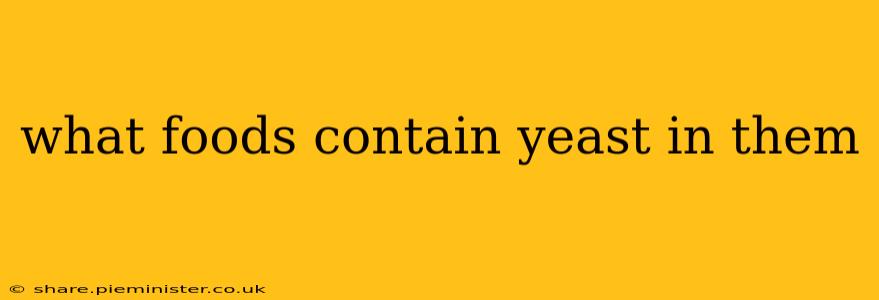What Foods Contain Yeast? A Deep Dive into Yeast's Culinary Roles
Yeast, a single-celled fungus, plays a crucial role in many culinary traditions, lending a characteristic rise and flavor to various foods. While some people actively seek out yeast-rich foods, others need to be aware of its presence due to dietary restrictions or allergies. This comprehensive guide will explore various foods containing yeast, addressing common questions along the way.
What are the most common foods containing yeast?
Many foods we consume daily contain yeast, often as a key ingredient in baking or as a byproduct of fermentation. The most common examples include:
-
Bread: This is perhaps the most well-known example. Baker's yeast (Saccharomyces cerevisiae) is used to leaven bread, causing it to rise and develop its characteristic texture. Various types of bread, from sourdough to artisan loaves, utilize yeast in their production.
-
Beer: Yeast is essential in the brewing process. Different strains of yeast contribute unique flavors and aromas to various beers.
-
Wine: Similar to beer, wine production relies heavily on yeast fermentation of grape sugars. The specific yeast strains used influence the wine's final taste profile.
-
Certain Cheeses: Some cheeses, particularly those undergoing fermentation, contain yeast. These yeasts contribute to the cheese's characteristic flavor and rind development. Examples might include some aged cheeses.
-
Soy Sauce: The fermentation process used to create soy sauce relies on yeast and other microorganisms.
-
Vinegar: Yeast is involved in the initial stages of vinegar production, converting sugars into alcohol, which then converts into acetic acid.
What foods are made with yeast extract?
Yeast extract, a byproduct of yeast production, is a common flavor enhancer and ingredient in various processed foods. It's a source of umami flavor and often found in:
-
Soups and broths: Many commercially produced soups and broths use yeast extract to enhance their savory taste.
-
Processed meats: Some processed meats contain yeast extract as a flavoring agent.
-
Seasoning blends: Yeast extract is sometimes included in commercial seasoning blends to add depth of flavor.
-
Margarine and spreads: Some margarine and spreads incorporate yeast extract for flavor and texture.
Does all bread contain yeast?
No, not all bread contains yeast. Some breads are leavened using other methods:
-
Sourdough bread: Relies on a sourdough starter, a naturally occurring culture of wild yeasts and bacteria.
-
Quick breads: These are often leavened with baking powder or baking soda, instead of yeast. Examples include muffins, scones, and biscuits.
Are there hidden sources of yeast in food?
While the foods listed above are the most prominent sources, yeast can be a hidden ingredient in some processed foods, due to its use as a flavor enhancer or stabilizer. Always check food labels for ingredients such as "yeast extract," "autolyzed yeast," or "yeast nutrient."
Is yeast in food harmful?
For most people, yeast in food is not harmful. However, individuals with yeast allergies or sensitivities may experience symptoms such as digestive upset, skin rashes, or respiratory problems. Those with Candida overgrowth may also want to monitor their yeast intake. If you suspect a yeast allergy or sensitivity, consult with a healthcare professional or allergist.
This detailed overview should provide a comprehensive understanding of yeast's presence in various foods. Remember to always read food labels carefully and consult with a healthcare professional if you have concerns about yeast intake.
